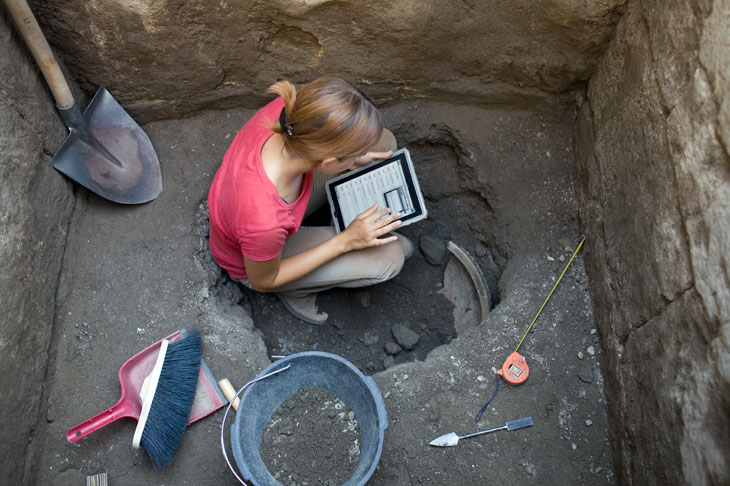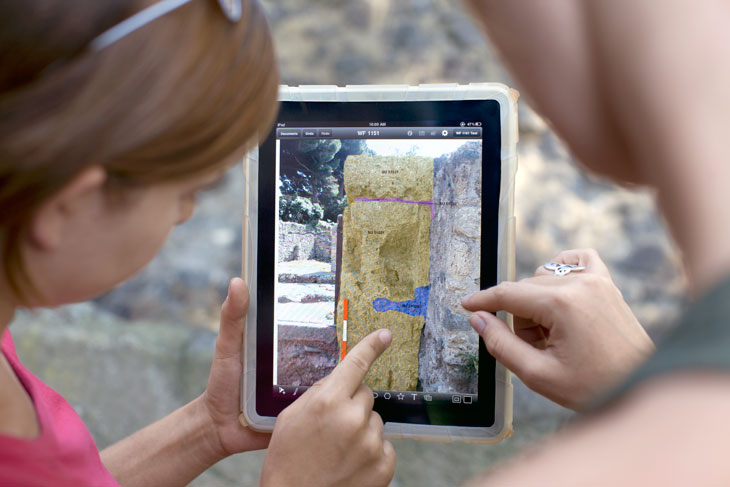Ever since Gordon Childe attempted to record the entire Skara Brae excavation on a prototype Etch A Sketch, archaeologists have hunted high and low for the holygrail in trench technology: a paperless device that can take the library to the site and the site to the library in one easy seamless move.
Apple have led the computer industry in innovation for the last three decades, spearheading the digital media revolution with the iPod, iTunes, and since May 2010, the iPad – a product, some would say, that is set to define the future of mobile media and computer devices. But even diggingthedirt, Apple fans that we are, were incredulous when the company announced on their website this week that they had found the answer to our prayers:
“For Dr. Steven Ellis, who directs the University of Cincinnati’s archaeological excavations at Pompeii, perhaps the most significant discovery at the site this year was iPad.”
Now, we take things pretty literally round here, so our first thoughts were ‘Oh My God! They’ve found an iPad!? That’s going to totally screw up accepted understanding for early Flavian Dynasty Roman technology.’ Reading further we realised that ‘significant discovery’ was marketing speak for ‘bought some iPads.’ The photo-story continued:
“Ellis credits the introduction of six iPad devices at Pompeii with helping his team solve one of the most difficult problems of archaeological fieldwork…”
…Most difficult problems… Hmmn, what could that be? Hangovers? Soiled Portaloos? STD’s? Or perhaps its that age old conundrum:
“…how to efficiently and accurately record the complex information they encounter in the trenches.”
So basically doing our job is the most difficult thing about doing our job.
OWKAY THEN!
 Marketing guff aside, it didn’t stop us marvelling, as we always do, at photos of shiny things in muddy holes. Ellis and his team of 35 are excavating an entire block of Pompeii – a working-class district (modest houses, shops, workshops, and hospitality outlets) that sat in the shadow of to the so-called ‘entertainment district’. The iPad is wrapped in a protective, dust proof case, and is used to fill in context sheets, make sketch plans, add to an unfolding Harris matrix, and consult digital photos. This all sounds like standard fare, and perhaps that’s the point of issue. We might be falling victim to what sociologists call ‘space pen’ syndrome…
Marketing guff aside, it didn’t stop us marvelling, as we always do, at photos of shiny things in muddy holes. Ellis and his team of 35 are excavating an entire block of Pompeii – a working-class district (modest houses, shops, workshops, and hospitality outlets) that sat in the shadow of to the so-called ‘entertainment district’. The iPad is wrapped in a protective, dust proof case, and is used to fill in context sheets, make sketch plans, add to an unfolding Harris matrix, and consult digital photos. This all sounds like standard fare, and perhaps that’s the point of issue. We might be falling victim to what sociologists call ‘space pen’ syndrome…
For much of the 1960’s the Soviet Union was locked in a bitter struggle with the United States for dominion of heaven and earth. The business end of the space race was seeing who could be first to play golf on the moon. The public lapped this up by the gobfull, but for those in the know, this was a mere sideshow to the real contest: the invention of a pen that would work in zero gravity. Early spaceships were about as technologically advanced as a dodgy Tesco’s shopping trolley, and needed continuous monitoring by spacemen with clipboards to make sure they didn’t explode. The Americans spent millions of dollars and years of research, eventually coming up with a roller-ball design to ensure the ink would run freely whatever the atmospheric condition. The Russians, well, they used a pencil.
So back now to the iPad. Lovingly cradled by bronzed archaeologists in sunnier climes, the photos scream ‘want one want one want one.’ But what’s wrong with our trusty pencils? Is this highly desirable new computer really a game-changing device for archaeology?
i-Do, or i-Don’t.
You decide…


Don’t talk soft lad! Pencils? I didn’t get where I am today with bloody pencils! Dig deep sunshine, and splash the cash. You know it makes sense.
I’ve been working in the field in Northern Arizona for a few seasons now. I have to admit to loving the trusty old pencil. However, once we’re out of the field, the pencils get laid aside and the computers take over. We type up nearly word for word the field notes we wrote in pencil. The photos we took of the sites have to be organized in a separate program. Everything is stored in two or three places on different computers and in online databases. Yes, I do love the pencil, but it would be wonderfully efficient to do everything on the computer so as to not have to digitize everything later. If everything (site record, site map, site photographs, etc.) could be recorded digitally in the field, it would save time and money in the long run.
Most difficult problem in archaeology? The smart git with the iPad in the ditch section next to you.
He can pull up the context sheets from the previous section without trudging back to the site hut or consulting the folder from underneath a wheelbarrow.
He can check his drawing number and whether a sample has been taken without (once discovering the registers are obscured by muddy fingerprints) rifling through buckets stacked like enormous skittles or permatrace sheets arranged like curtains.
He can annotate a photo rather than describe. He can check online when he forgets how to spell pod… podzol… podzolising? He can even check facebook and buy new boots by the time you’ve remembered whether the ‘a’ is in or out of ‘medieval’ these days.
Until… he’s 2m down a cess pit and loses the network.
Thanks for the comments – streamlining post-ex (i-do) and losing connectivity (i-don’t) – both good points. I don’t know what it’s like for people in sunnier climes, but the main issue for archaeologists in the UK and Ireland is that the country is completely submerged by water for 7 months of the year.
https://www.diggingthedirt.com/2009/09/12/riders-on-the-storm/
Has anyone got any experience of using one in the field, or ideas about where it might all be going? It would be good to hear from anyone on the project team – find out if this is anything more than a super-slick marketing campaign.
Well, you don’t do your research too well for an archaeologist, one quick google would prove your space pen thing to be crap, everyone used pencils but they are an inherent risk to machinery (graphite shards are not ideal partners to delicate instruments), so some guy invented the space pen (NOT NASA) and then both the American and Russian space programs decided to adopt it.
http://www.scientificamerican.com/article.cfm?id=fact-or-fiction-nasa-spen
I don’t see what the problem is using something like this to help you record your data in a clearer fashion. Nice to be able to use it as camera that you can add notes to the pictures straight away no? I’m no archaeologist, but looks pretty handy to me!
Just felt like you were trying to capitalise on this news story, but you have managed to make yourself sound like a luddite for the sake of it…
Woops! Thanks Krudler for pointing that out – sloppy research indeed! I’ve fact checked the rest of the post and it turns out Gordon Childe didn’t record Skara Brae with a prototype Etch-A-Sketch either! And guess what else I found out whist ‘researching’ on Google?
The chicken didn’t actually cross the road, an Englishman, Irishman and Scotsman never walked into a bar, and Doctor Who didn’t knock knock on any ones door.
Oh what joy: sharing my innermost thoughts with the witless. But as the man says, fuck’em if they can’t take a joke.
Now, has anyone got anything relevant to say before I go all Luddite on this computer’s ass?
Enjoyed your note and even got the jokes!
I just finished doing 5 weeks volunteering at a local dig in Scotland. The way the scheduling worked out, I ended up doing a lot of the drawings, sectionals etc..
Being a low level tech-weanie I spent a lot of my off time trying to figure out how best to integrate technology and archeology. Now someone has. ‘Cool’ I say. Yes, I know there are any number of jokes that can be made from that statement.
I’m now curious to see what people to do to protect these delicate items.
Check it out:
http://mobilearch.blogspot.com/
This blog will be exploring the possibilities of mobile archaeology, first post was a review on the Pompeii case study. Author has field experience with iPad. Looking forward to what is to come.
Hi H-Train,
Checked out Mobile Arch – Excellent blog, and good assessment of the practicality of the iPad, cutting through the marketing guff to really assess the usefulness of this new technology.
All the best and keep it up!
The archaeologists working at Pompeii with iPads are the University of Cincinnati and have a number of on-line resources discussing their use of these pieces of technology. I bought one explicitly for fieldwork and have found the following:
1. I am more technology-challenged than I had hoped;
2. The nature of the iPad is such that you cannot hit the ground running. There is definitely a learning curve since it is not a mini-computer, rather it is a large iPod/iPhone;
3. It pays to do your homework on which apps are best for what you want/need it to do;
4. The iPad is quite useful for non-field things — for instance I used it for my presentation notes at a conference recently. Super easy to read from and seamless page changes;
5. There are a lot of good and practical applications for classroom teaching that I plan to try out.
So, it may not be a magic box, but I like the idea of saving paper (and not having to send an undergrad to the copy shop to pay 20cents a page when we run out of field forms), having data digitized from the get-go (thus saving time post-field), etc.
http://classics.uc.edu/pompeii/index.php/news/1-latest/142-ipads2010.html
The one is best read from the earliest posts onward:
http://paperlessarchaeology.com/
Good set of answers – and great to hear directly from someone who’s used one in the field (rather than the rest of us, who should be so lucky!).
If a site director was interesting in implementing this technology where would they be able to find the application package being implemented on the ipad?
Thanks!
Hi there – check out this film – part way through you’ll find yours truly discussing my own forays into iPadology…
http://digventures.com/2012/08/13/flag-fen-lives-day-20/
Which application do they use in the ipad to do archaeological work?